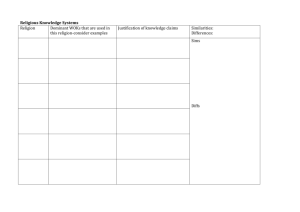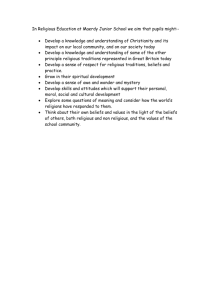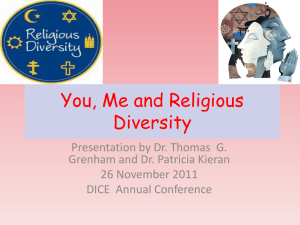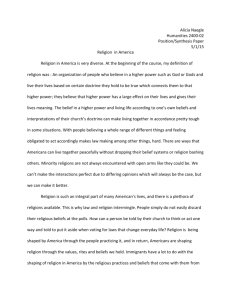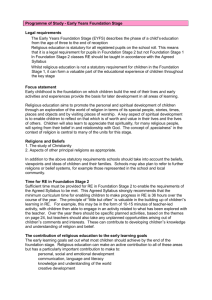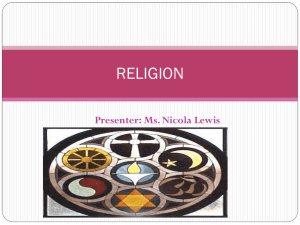RE Skills - East Dene
advertisement
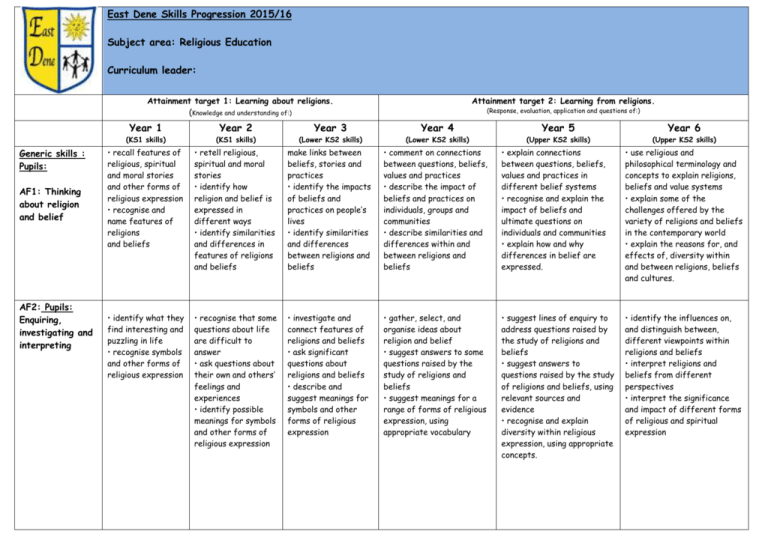
East Dene Skills Progression 2015/16 Subject area: Religious Education Curriculum leader: Attainment target 1: Learning about religions. (Knowledge and understanding of:) Generic skills : Pupils: AF1: Thinking about religion and belief AF2: Pupils: Enquiring, investigating and interpreting Attainment target 2: Learning from religions. (Response, evaluation, application and questions of:) Year 1 Year 2 Year 3 Year 4 Year 5 Year 6 (KS1 skills) (KS1 skills) (Lower KS2 skills) (Lower KS2 skills) (Upper KS2 skills) (Upper KS2 skills) • recall features of religious, spiritual and moral stories and other forms of religious expression • recognise and name features of religions and beliefs • retell religious, spiritual and moral stories • identify how religion and belief is expressed in different ways • identify similarities and differences in features of religions and beliefs make links between beliefs, stories and practices • identify the impacts of beliefs and practices on people’s lives • identify similarities and differences between religions and beliefs • comment on connections between questions, beliefs, values and practices • describe the impact of beliefs and practices on individuals, groups and communities • describe similarities and differences within and between religions and beliefs • explain connections between questions, beliefs, values and practices in different belief systems • recognise and explain the impact of beliefs and ultimate questions on individuals and communities • explain how and why differences in belief are expressed. • use religious and philosophical terminology and concepts to explain religions, beliefs and value systems • explain some of the challenges offered by the variety of religions and beliefs in the contemporary world • explain the reasons for, and effects of, diversity within and between religions, beliefs and cultures. • identify what they find interesting and puzzling in life • recognise symbols and other forms of religious expression • recognise that some questions about life are difficult to answer • ask questions about their own and others’ feelings and experiences • identify possible meanings for symbols and other forms of religious expression • investigate and connect features of religions and beliefs • ask significant questions about religions and beliefs • describe and suggest meanings for symbols and other forms of religious expression • gather, select, and organise ideas about religion and belief • suggest answers to some questions raised by the study of religions and beliefs • suggest meanings for a range of forms of religious expression, using appropriate vocabulary • suggest lines of enquiry to address questions raised by the study of religions and beliefs • suggest answers to questions raised by the study of religions and beliefs, using relevant sources and evidence • recognise and explain diversity within religious expression, using appropriate concepts. • identify the influences on, and distinguish between, different viewpoints within religions and beliefs • interpret religions and beliefs from different perspectives • interpret the significance and impact of different forms of religious and spiritual expression recount outlines of some religious stories retell religious stories and identify some religious beliefs and teachings describe some religious beliefs and teachings of religions studied, and their importance Practices and lifestyles recognise features of religious life and practice identify some religious practices, and know that some are characteristic of more than one religion describe how some features of religions studied are used or exemplified in festivals and practices Expression and language recognise some religious symbols and words suggest meanings in religious symbols, language and stories Identity and experience (making identify aspects of own experience and feelings, in religious material studied Meaning and purpose Values and commitments Beliefs and teachings describe the key beliefs and teachings of the religions studied, connecting them accurately with other features of the religions making some comparisons between religions show understanding of the ways of belonging to religions and what these involve explain how some beliefs and teachings are shared by different religions and how they make a difference to the lives of individuals and communities make links between religious symbols, language and stories and the beliefs or ideas that underlie them show, using technical terminology, how religious beliefs, ideas and feelings can be expressed in a variety of forms, giving meanings for some symbols, stories and language explain how some forms of religious expression are used differently by individuals and communities compare the different ways in which people of faith communities express their faith. respond sensitively to the experiences and feelings of others, including those with a faith compare aspects of their own experiences and those of others, identifying what influences their lives ask questions about the significant experiences of key figures from religions studied and suggest answers from own and others' experiences, including believers make informed responses to questions of identity and experience in the light of their learning discuss and express their views on some fundamental questions of identity, meaning, purpose and morality related to Christianity and other faiths. identify things they find interesting or puzzling, in religious materials studied realise that some questions that cause people to wonder are difficult to answer compare their own and other people's ideas about questions that are difficult to answer ask questions about puzzling aspects of life and experiences and suggest answers, making reference to the teaching of religions studied make informed responses to questions of meaning and purpose in the light of their learning express their views on some fundamental questions of identity, meaning, purpose and morality related to Christianity and other faiths. identify what is of value and concern to themselves, in religious material studied respond sensitively to the values and concerns of others, including those with a faith, in relation to matters of right and wrong make links between values and commitments, including religious ones, and their own attitudes or behaviour ask questions about matters of right and wrong and suggest answers that show understanding of moral and religious issues make informed responses to people's values and commitments (including religious ones) in the light of their learning make informed responses to people's values and commitments (including religious ones) in the light of their learning They will use different techniques to reflect deeply (what people believe) (what people do) (how people express themselves) sense of who we are) (making sense of life) (making sense of right and wrong) explain how selected features of religious life and practice make a difference to the lives of individuals and communities make comparisons between the key beliefs, teachings and practices of the Christian faith and other faiths studied, using a wide range of appropriate language and vocabulary. explain in detail the significance of Christian practices, and those of other faiths studied, to the lives of individuals and communities. SKILLS AND PROCESSES TO BE DEVELOPED THROUGH RELIGIOUS EDUCATION Progression in RE depends upon the development of the following generic learning skills applied to RE. These skills should be used in developing a range of activities for pupils to demonstrate their capabilities in RE. They ensure that teachers will move pupils on from knowledge accumulation and work that is merely descriptive to higher level thinking and more sophisticated skills. R Reflection – this includes: • Reflecting on feelings, relationships, experience, ultimate questions, beliefs and practices E Empathy – this includes: • Considering the thoughts, feelings, experiences, attitudes, beliefs and values of others • Developing the ability to identify feelings such as love, wonder, forgiveness and sorrow • Seeing the world through the eyes of others, and seeing issues from their point of view Investigation – this includes: • Asking relevant questions • Knowing how to gather information from a variety of sources • Knowing what may constitute evidence for justifying beliefs in religion Interpretation – this includes: • Drawing meaning from artefacts, works of art, music, poetry and symbolism • Interpreting religious language • Suggesting meanings of religious texts Evaluation – this includes: • Debating issues of religious significance with reference to evidence and argument Analysis – this includes: • Distinguishing between opinion and fact • Distinguishing between the features of different religions Synthesis – this includes: • Linking significant features of religion together in a coherent pattern • Connecting different aspects of life into a meaningful whole Application – this includes: • Making the association between religion and individual, community, national and international life Expression – this includes: • Explaining concepts, rituals and practices • Expressing religious views, and responding to religious questions through a variety of media
